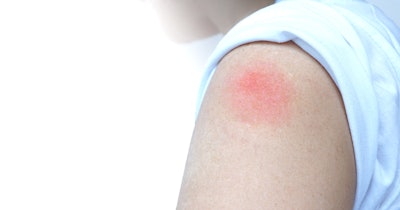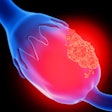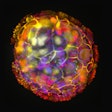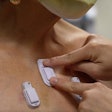
A recent invention provides a simple, convenient, and effective way to monitor wound recovery, triggering timely clinical intervention that can improve wound care and management. The design and fabrication of this device, called the PETAL sensor patch, was reported in Science Advances on June 16.
Typically, wound healing is visually assessed by clinicians. Infections are diagnosed via swabbing and bacterial culture. However, this process fails to provide timely wound diagnosis, or accurately predict wound healing. Wound assessment also usually requires frequent dressing changes, elevating infection risks and causing additional pain.
Researchers sought an innovative solution to benefit patients with complex wounds. Their paper-like, battery-free, in situ artificial intelligence (AI)-enabled multiplexed PETAL sensor patch comprises five colorimetric sensors that can effectively assess a patient’s wound healing status by measuring a combination of carefully selected biomarkers, including temperature, pH, trimethylamine, uric acid, and wound moisture.
Each PETAL sensor patch consists of a fluidic panel patterned in the form of a five-petaled pinwheel flower. Each “petal” acts as a sensing region. An opening in the center of the fluidic panel collects fluid from the wound and distributes it evenly to the sensing regions for analysis. Each sensing region uses a different color-changing chemical to detect and measure the respective wound indicators.
The fluidic panel is sandwiched between two thin films. The top transparent silicone layer allows for normal skin oxygen and moisture exchange functions; it also enables image display for analysis. The bottom wound contact layer gently attaches the sensor patch to the skin and protects the wound bed from direct contact with the sensor panel. After sufficient wound fluid is accumulated, the PETAL sensor patch completes the detection of biomarkers within 15 minutes.
The sensor patch’s images are captured via mobile phone and rapidly analyzed by AI algorithms to determine the patient’s healing status without removing the sensor from the wound. This allows doctors and patients to monitor wounds more regularly without interrupting wound healing. Timely medical intervention can then be administered appropriately to prevent adverse complications.
The current study demonstrated the PETAL sensor patch’s performance on chronic wounds and burn wounds. The patch showed 97% accuracy in differentiating healing and non-healing chronic and burn wounds. No apparent adverse reactions from skin contact with the patch were observed over four days.
Researchers say this technology can be adapted and customized for other wound types. An international patent for their invention has been filed; the researchers plan to advance to human clinical trials.
"We designed the paper-like PETAL sensor patch to be thin, flexible, and biocompatible, allowing it to be easily and safely integrated with wound dressing for the detection of biomarkers,” Dr. Su Xiaodi, principal scientist at the A*STAR Institute of Materials Research and Engineering’s soft materials department, explained in a statement. “We can thus potentially use this convenient sensor patch for prompt, low-cost wound care management at hospitals or even in non-specialist healthcare settings such as homes.”



















